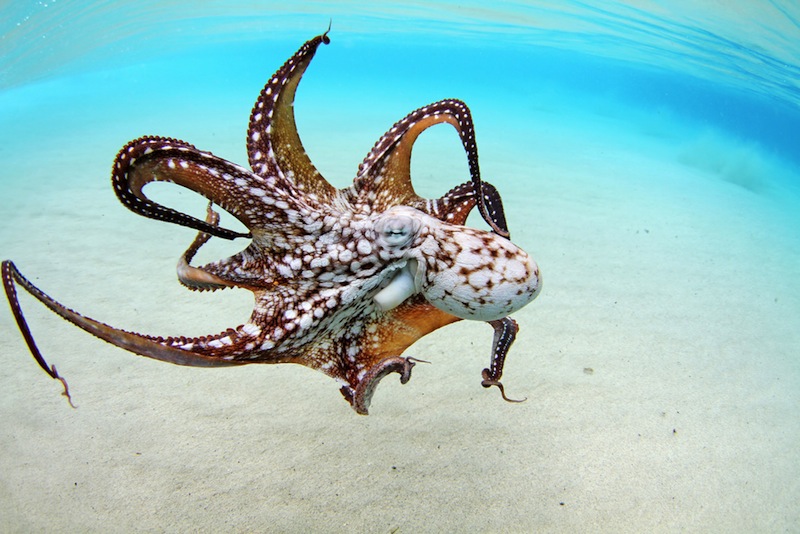Animal Sex: How Octopuses Do It

Often considered the smartest invertebrates (animals without backbones) on the planet, octopuses can use tools, unscrew jar lids and tightly control their body color to match their surroundings. They use this sharp intelligence especially in situations of survival — including when they are trying to avoid getting eaten by their hungry mates.
Octopuses come in all shapes and sizes and inhabit diverse regions of the ocean. There are about 100 different species of octopuses in the genus Octopus, and at least another 150 species in other genera, said Jennifer Mather, a cephalopod expert at the University of Lethbridge in Canada. Scientists have witnessed the mating behavior of only about a dozen species, she added.
The marine animals have very short lives, generally lasting only a few years long and sometimes as short as 6 months. They spend their youth alone, eating and growing before reaching sexual maturity. [8 Crazy Facts About Octopuses]
"Then they become sexually mature, metabolize their muscles to make eggs and sperm and begin to mate," Mather told Live Science.
Love displays
It's unclear how mature male and female octopuses find each other in the vast ocean. Males appear to devote a lot time searching for mates, while females typically become less active in adulthood and possibly draw males to them using chemical cues.
Because they're solitary animals, octopuses aren't exactly picky with their mates. "Females don't usually refuse males," Mather said. However, that's not to say the clever cephalopods have no courtship rituals to entice potential mates.
Get the world’s most fascinating discoveries delivered straight to your inbox.
Male common octopuses (Octopus Vulgaris), for instance, are known to rear up and display several large suckers on the underside of their tentacles to identify themselves as male, but only if approaching a larger female, which may decide to attack and eat them. They will also spread themselves out to appear large, and turn a dark or pale coloration.
A male day octopus (O. Cyanea), on the other hand, will stand tall and tower over his potential mate, while turning pale — as he approaches a female, he'll flash a distinctive pattern of black stripes across his body.
Abdopus aculeatushas one of the most complex sexual behaviors among octopuses. In this species, a male will guard a female from other males, typically while staying in a den in tentacle's reach of the female's den. If another male comes by, he pushes and grapples with his competition, a fight that may end in a fatality.
To identify their sex, male A. aculeatus keep a black- and white-stripe pattern on their bodies while in the presence of a female and during aggressive encounters, and females remain camouflaged. Some "sneaker" males use these telltale signals to their advantage by matching their body color to the female's — this allows them to creep past a guarding male and mate with the female secretively.
A dangerous game
Mating for males is a dangerous game due to the female's penchant for cannibalism. To avoid getting eaten, they'll often mate from a distance or after mounting the back of a female's mantle — positions that give them extra time to escape should their (usually larger) mate turn violent.
Unlike females, "males have a modified third right arm called a hectocotylus, which has a sperm groove down it and a specialized tip," Mather said. To mate, a male will insert his hectocotylus into the female's mantle cavity and deposit spermatophores (sperm packets). This process may take up to several hours, depending on the species.
In some genera, particularly those in which males are far smaller than females, such as Argonauta (argonauts, or paper nautiluses) and Tremoctopus (blanket octopuses), males have a detachable hectocotylus, which they break off after inserting it into the female's mantle.
Females store their spermtophores until they're ready to lay their eggs. Typically, males die within months after mating, while females watch over their eggs until they hatch and then die shortly after. In one deep-sea species, Graneledone boreopacifica, females may brood over their eggs for up to 4.5 years without ever leaving to eat.
The larger Pacific striped octopus, which doesn't yet have a formal name, appears to break the octopus mating rules. In this odd social species, mating takes place mouth-to-mouth and sucker-to-sucker — and these females don't practice cannibalism. What's more, the females can lay multiple clutches of eggs before dying.
Follow Joseph Castro on Twitter. Follow us @livescience, Facebook & Google+.



